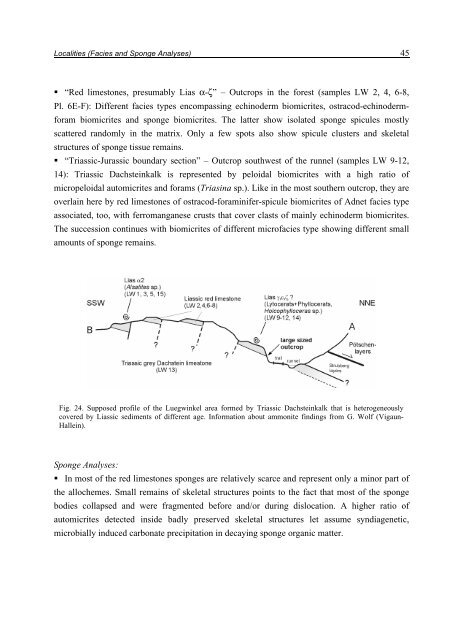Porifera-microbialites of the Lower Liassic (Northern Calcareous ...
Porifera-microbialites of the Lower Liassic (Northern Calcareous ...
Porifera-microbialites of the Lower Liassic (Northern Calcareous ...
Create successful ePaper yourself
Turn your PDF publications into a flip-book with our unique Google optimized e-Paper software.
Localities (Facies and Sponge Analyses) 45<br />
� “Red limestones, presumably Lias α-ζ” – Outcrops in <strong>the</strong> forest (samples LW 2, 4, 6-8,<br />
Pl. 6E-F): Different facies types encompassing echinoderm biomicrites, ostracod-echinoderm-<br />
foram biomicrites and sponge biomicrites. The latter show isolated sponge spicules mostly<br />
scattered randomly in <strong>the</strong> matrix. Only a few spots also show spicule clusters and skeletal<br />
structures <strong>of</strong> sponge tissue remains.<br />
� “Triassic-Jurassic boundary section” – Outcrop southwest <strong>of</strong> <strong>the</strong> runnel (samples LW 9-12,<br />
14): Triassic Dachsteinkalk is represented by peloidal biomicrites with a high ratio <strong>of</strong><br />
micropeloidal automicrites and forams (Triasina sp.). Like in <strong>the</strong> most sou<strong>the</strong>rn outcrop, <strong>the</strong>y are<br />
overlain here by red limestones <strong>of</strong> ostracod-foraminifer-spicule biomicrites <strong>of</strong> Adnet facies type<br />
associated, too, with ferromanganese crusts that cover clasts <strong>of</strong> mainly echinoderm biomicrites.<br />
The succession continues with biomicrites <strong>of</strong> different micr<strong>of</strong>acies type showing different small<br />
amounts <strong>of</strong> sponge remains.<br />
Fig. 24. Supposed pr<strong>of</strong>ile <strong>of</strong> <strong>the</strong> Luegwinkel area formed by Triassic Dachsteinkalk that is heterogeneously<br />
covered by <strong>Liassic</strong> sediments <strong>of</strong> different age. Information about ammonite findings from G. Wolf (Vigaun-<br />
Hallein).<br />
Sponge Analyses:<br />
� In most <strong>of</strong> <strong>the</strong> red limestones sponges are relatively scarce and represent only a minor part <strong>of</strong><br />
<strong>the</strong> allochemes. Small remains <strong>of</strong> skeletal structures points to <strong>the</strong> fact that most <strong>of</strong> <strong>the</strong> sponge<br />
bodies collapsed and were fragmented before and/or during dislocation. A higher ratio <strong>of</strong><br />
automicrites detected inside badly preserved skeletal structures let assume syndiagenetic,<br />
microbially induced carbonate precipitation in decaying sponge organic matter.

















